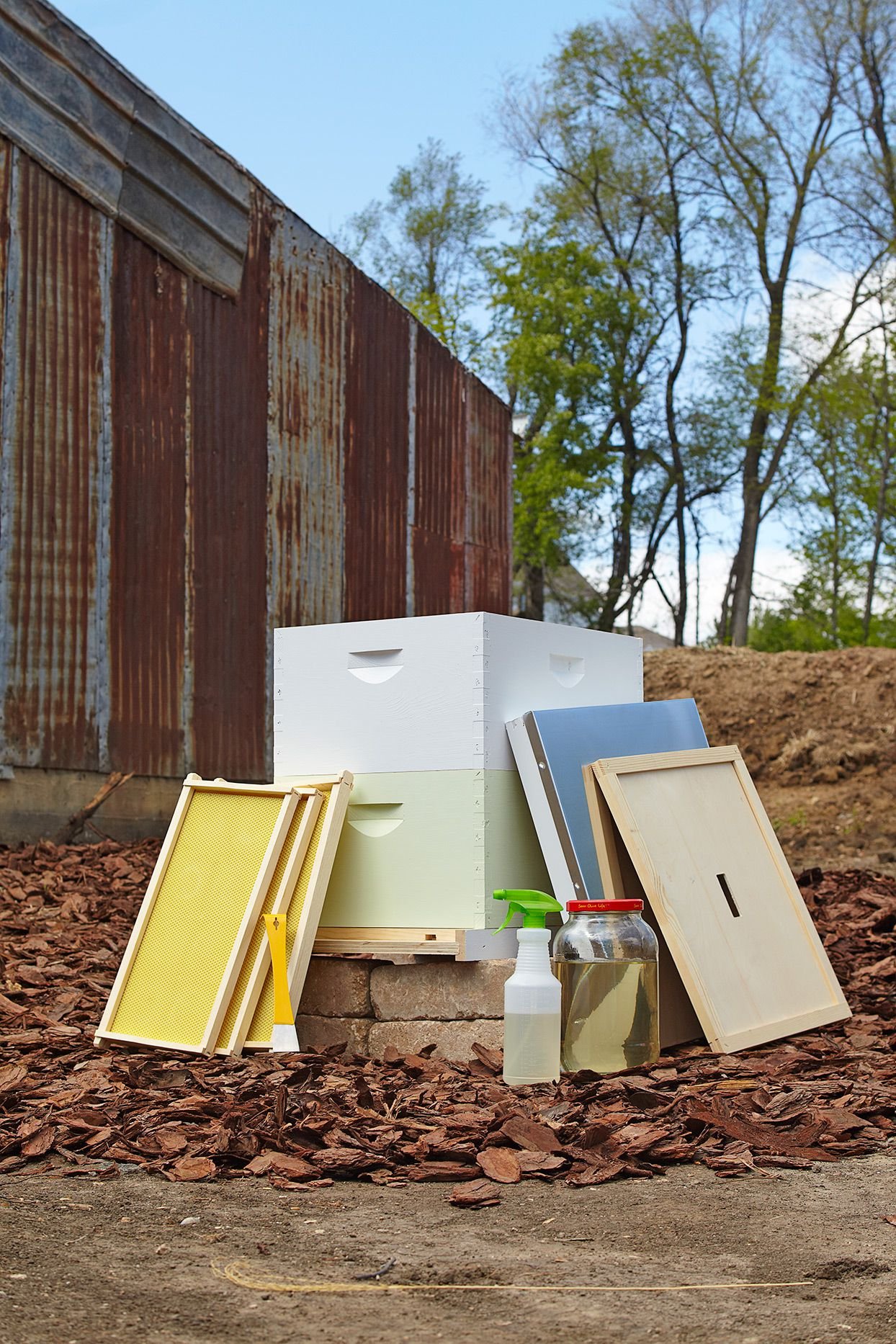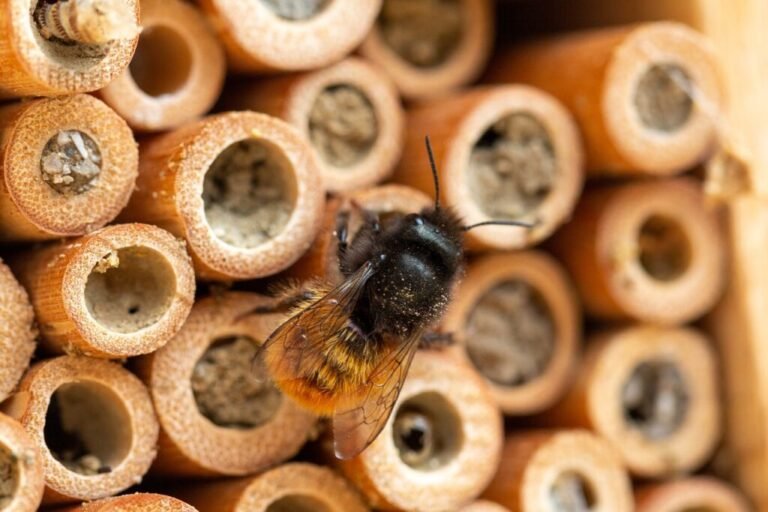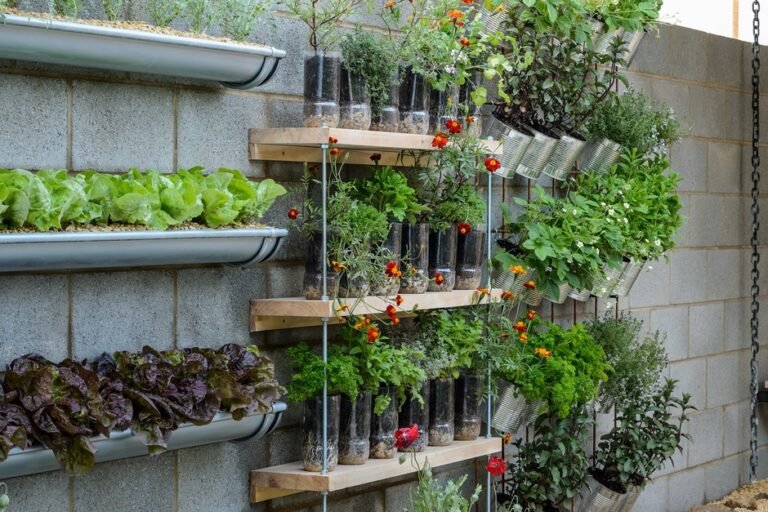Bees play a crucial role in our ecosystem, pollinating plants and supporting biodiversity. Yet, their habitats are in decline.
Creating a bee hotel is a fun, rewarding way to help these vital insects thrive. In just five simple steps, anyone can build a safe haven for bees right in their backyard. Imagine a bustling mini-resort for bees, buzzing with life, right outside your window.
A bee hotel is not only a sanctuary for these hardworking pollinators; it’s a garden’s statement piece that sparks conversations. This guide simplifies the process, breaking it down into manageable tasks. Whether you’re a seasoned gardener or a DIY novice, you’ll find joy in crafting a cozy retreat for our striped friends. Grab some basic tools and materials, and let’s dive into the world of bee conservation. Your journey to becoming a bee-friendly champion starts here.
Introduction To Bee Hotels
Bee hotels are simple structures that offer solitary bees a place to nest. Unlike honeybees, solitary bees don’t live in hives. They need their own space. A bee hotel can be that space. It’s easy to build and helps these vital pollinators thrive.
Why Bees Matter
Bees play a critical role in pollinating plants. Many crops depend on them. Without bees, foods like fruits, nuts, and vegetables would be in trouble. Bees also support the growth of trees, flowers, and other plants, which serve as food and shelter for creatures large and small.
Benefits Of A Bee Hotel
- Boosts bee populations: Provides nesting sites for bees.
- Enhances gardens: Improves pollination for a better yield.
- Supports biodiversity: Helps maintain ecological balance.
Selecting The Right Location
Bees need a safe and comfy home. Just like us! Picking where to place a bee hotel is key. Get it right, and you’ll see these friendly pollinators buzz with joy. Let’s explore the best spot to set up a bee haven.
Sun Exposure
Bee hotels thrive in the morning sun. It warms up the bees. Choose a place that gets the first light. Avoid too much shade. A bit of afternoon shade is fine. It keeps the hotel from getting too hot.
Protection From Elements
Bees need a spot safe from rain and wind. A spot under an eave or tree branch works well. Make sure it’s not too damp. A dry bee hotel means happy bees. Keep it off the ground. This helps to stop wet soil and unwanted guests.
Gathering Materials
Building a bee hotel is a fun, rewarding project. It helps bees. We need bees for healthy gardens. First, let’s gather the right materials. This guide makes it easy.
Natural And Recycled Options
Using natural and recycled materials is best. It’s good for the earth and bees. Here’s what you need:
- Bamboo canes – for bee rooms.
- Wood blocks – also for bee rooms.
- Straw – for insulation.
- Old wood – for the hotel structure.
- Empty cans – as hotel rooms.
Look around your home. You might find these items. No need to buy new.
Tools Needed
Now, let’s talk tools. You need a few:
- Drill – for making holes in wood.
- Saw – to cut wood to size.
- Hammer and nails – to put it all together.
- Sandpaper – to smooth rough edges.
Most of these tools are common. You might already have them.
:strip_icc()/beekeeper-bees-in-brood-box-9146e157-7c3f160863214eebbcaf294482212726.jpg)
Designing Your Bee Hotel
Welcome to the world of urban bee conservation through DIY initiatives! Designing a bee hotel can be both fun and beneficial for the environment. Follow these steps to create a safe haven for our buzzing friends.
Size And Structure
Consider the size of your bee hotel. It should be large enough to host several bees, yet small enough to manage easily. A good starting point is a structure that’s at least 8 inches tall and wide.
Use natural materials like wood or bamboo. These materials mimic the bees’ natural nesting sites. Avoid treated woods as they can be harmful to bees.
Ensure your bee hotel has a solid back and roof. This protects the bees from predators and harsh weather. The roof should overhang to keep the nesting tubes dry.
Creating Bee-friendly Spaces
Drill holes in blocks of wood. These holes are where solitary bees will lay their eggs. The holes should be between 2mm and 10mm in diameter to cater to different bee species.
- Use a variety of hole sizes
- Keep holes a few inches deep
- Smooth the entrance of the holes to prevent bee wings from damage
Bamboo tubes can also be used. Cut them to length and bundle them together. This creates additional nesting space for bees.
Place the bee hotel facing south-east. This ensures it gets the morning sun. Bees need warmth to become active.
With these steps, your bee hotel is ready to welcome guests!
Assembling The Structure
Building a bee hotel invites these vital pollinators into your garden. A safe haven for bees means a thriving ecosystem. Let’s roll up our sleeves and start the construction with ease and safety in mind.
Step-by-step Construction
- Collect Materials: Gather untreated wood, bamboo canes, and a saw.
- Measure and Cut: Cut the wood into back, sides, and roof pieces.
- Drill Holes: In the wood blocks, drill various sized holes for bees.
- Assemble Frame: Nail sides to the back piece, then attach the roof.
- Add Canes: Cut bamboo to length and pack into the frame tightly.
Safety Tips
- Wear Gloves: Protect hands from splinters and sharp edges.
- Use Eye Protection: Safety glasses shield eyes from debris.
- Secure Materials: Clamp wood when sawing or drilling.
- Check Tools: Ensure tools are in good condition before use.
- Be Mindful: Focus on the task to avoid accidents.
Adding The Finishing Touches
Now, you’ve built a bee hotel. It’s time for Adding the Finishing Touches. This part makes your hotel stand out and safe for bees. Let’s dive in.
Decorative Elements
Bees don’t just need a place to stay. They need a cozy and inviting one. Here’s how:
- Paint the outside. Use bright, non-toxic paint. Bees love color.
- Add some patterns. Stripes or dots can make it look fun.
- Use natural materials. Small stones, wood pieces, or even leaves can add a nice touch.
Making It Weatherproof
Your bee hotel needs protection from rain and wind. Follow these steps:
- Cover the top. Use a waterproof material like a plastic sheet or metal lid.
- Seal the edges. Use safe sealants to keep water out.
- Place it under shelter. A spot under a tree or eave can help.
With these steps, your bee hotel is now ready. Bees will have a safe and beautiful place to call home. Remember, a happy bee is a busy bee!
Mounting Your Bee Hotel
Bee hotels provide safe havens for solitary bees. These tiny pollinators play a crucial role in our ecosystem. Let’s look at how to properly mount your bee hotel to ensure these beneficial insects can thrive.
Ideal Height
Bees prefer their hotels to be off the ground. An ideal height is between 3 to 6 feet. This range keeps the bees safe from predators and moisture.
Securing The Hotel
Stability is key when mounting your bee hotel. Ensure it won’t sway in the wind. Use a backboard or sturdy materials to fix it against a flat surface.
- Choose a sunny, south-facing wall or fence.
- Use screws or strong wire to attach the hotel.
- Check the hotel is level so bees feel secure.
Maintenance And Care
Maintaining a bee hotel is crucial for the health of its tiny guests. Simple steps ensure a safe habitat for bees. Let’s dive into the maintenance and care of your bee hotel.
Cleaning Guidelines
Clean your bee hotel once a year. Wait until all bees have left their nests. Use a soft brush to remove debris. Check for mold or parasites. Replace hollow tubes if needed. Always use natural materials, as bees prefer these.
- Wait for bee activity to cease.
- Gently brush out nesting holes.
- Inspect for and clear any mold.
- Replace tubes and blocks periodically.
Seasonal Considerations
Protect your bee hotel from harsh weather. In winter, move it to a sheltered spot. This prevents moisture damage. During spring, place the hotel back in a sunny location. Ensure it’s facing south to catch the morning sun.
| Season | Action |
|---|---|
| Winter | Move to a sheltered area |
| Spring | Return to a sunny spot |
Regular check-ups help too. Look out for bee activity. Make sure the structure is secure. Your bee hotel will thrive with these easy care tips.
Encouraging Bees To Visit
Building a bee hotel is a great way to help bees. But first, you need to make them come. Here are easy steps to make bees love your hotel.
Attracting Native Bees
Native bees love certain things. Here’s what you can do:
- Keep water around. A small dish works well.
- Use natural materials. Wood and bamboo are good.
- Place the hotel where it gets morning sun.
Complementary Planting
Plants can help too. They bring more bees. Try these:
| Plant Type | Flowering Season |
|---|---|
| Lavender | Summer |
| Sunflower | Late Summer |
| Clover | Spring to Fall |
Choose plants that bloom at different times. This way, bees have food all year.
Monitoring And Observing
Monitoring and Observing your bee hotel is crucial. It helps track the success of your bee habitat. This phase is exciting and educational. You will witness the growth of your bee population. Let’s explore how to keep a detailed record and learn from your buzzing guests.
Keeping A Bee Diary
A bee diary is a fun way to note changes. You will need:
- Notebook or digital app
- Camera or smartphone
- Regular observation schedule
Start by jotting down:
- Date and time of observations
- Weather conditions
- Bee activity and species noted
- Hotel occupancy rate
Photos can capture progress. They can show new nests or bee types. Compare notes over weeks or months. Patterns will emerge. These insights can guide future bee hotel improvements.
Learning From Your Hotel
Your bee hotel is a living lab. Observe which nest types are popular. Record which materials attract the most bees. Are there more bees in sunny spots? Do they prefer mornings or afternoons? These observations can teach you about bee preferences and behaviors.
| Observation | Insight |
|---|---|
| Material types used | Preferences for nesting |
| Time of day for peak activity | Bee activity cycles |
| Weather impact on visits | Optimal conditions for bees |
Use these findings to make your bee hotel even better. Share your insights with others. Together, we can support our vital bee populations.
Expanding The Habitat
Bee hotels play a crucial role in boosting local ecosystems. They offer solitary bees a nesting place. This helps maintain plant pollination. Building more bee hotels can expand habitats. It encourages biodiversity. Let’s explore how to widen these safe havens for bees.
Adding More Hotels
Creating multiple bee hotels magnifies the impact. Place them in various locations. Ensure they face the morning sun. Use diverse materials. This invites different bee species. Here’s a simple guide:
- Choose sunny, sheltered spots.
- Use natural, untreated wood.
- Fill with bamboo tubes, drilled holes.
- Space hotels a few meters apart.
- Regularly check and maintain them.
Community Involvement
Engage your community for a wider reach. Schools, parks, and gardens are ideal. Organize workshops. Teach the importance of bees. Encourage others to build bee hotels. Together, you’ll create a network of habitats. Follow these steps:
- Coordinate with local groups.
- Set up informative sessions.
- Provide materials and guides.
- Install hotels in communal spaces.
- Monitor and share the progress.

Frequently Asked Questions
What Materials Are Needed For A Bee Hotel?
To build a bee hotel, you’ll need bamboo canes, untreated wood, a drill, screws, and a saw. Choose natural, untreated materials to ensure a safe environment for the bees.
How Do I Attract Bees To My Bee Hotel?
Place the bee hotel in a sunny, south-facing spot protected from wind. Plant native flowers nearby to provide essential food sources for the bees.
What Is The Best Size For A Bee Hotel?
The ideal bee hotel is at least 8 inches deep. This size allows enough space for different bee species. Tubes or holes should range from 2mm to 10mm in diameter.
When Is The Best Time To Install A Bee Hotel?
Install your bee hotel in early spring. This timing aligns with the emergence of solitary bees looking for nesting sites.
Conclusion
Creating a bee hotel is simpler than you may think. Follow these five steps and you’re all set. Your backyard will soon be a buzzing haven for bees. They play a key role in our ecosystem. So, your effort makes a big difference.
Think of the joy as you watch bees come and go. You’re giving these helpful insects a place to thrive. Ready to get started? Grab your tools and materials. Let’s help our buzzing friends with their new home. It’s a small step for you, but a giant leap for bee-kind.



